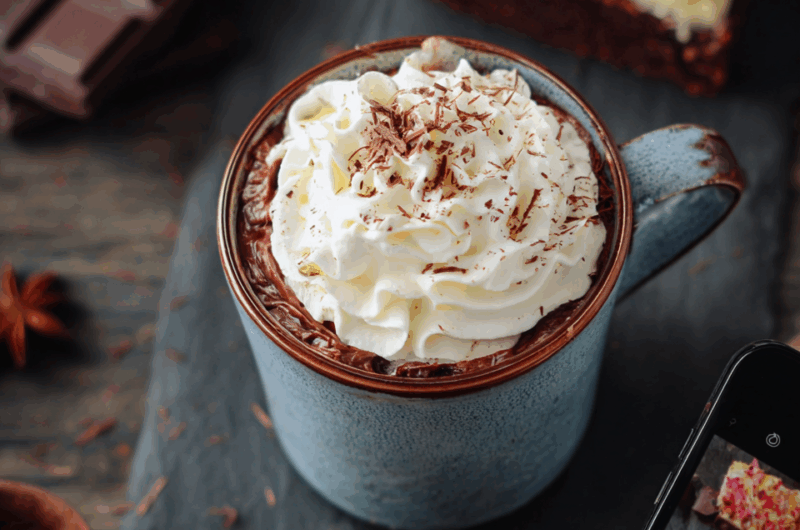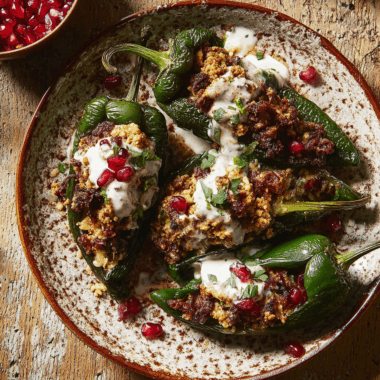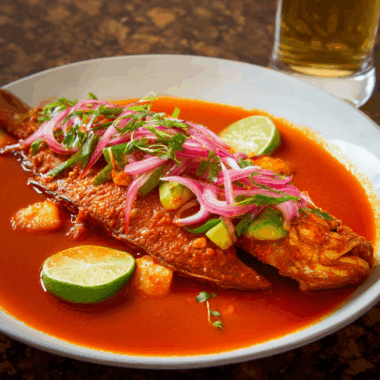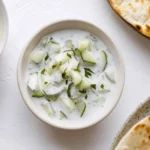This Mexican Hot Chocolate with Chile is not your average cocoa—it’s a comforting yet bold drink that blends rich chocolate with a touch of spice. The warmth of cinnamon and the subtle heat of chile create a perfect balance of sweet and fiery flavors, making every sip an experience.
Whether you’re curled up on a winter evening or serving it at a festive gathering, this traditional Mexican beverage brings a touch of authenticity and cozy charm to the table. It’s a treat that invites you to slow down, savor, and indulge in a centuries-old tradition that remains timeless and irresistible.
Full Recipe:
-
4 cups whole milk
-
3 ounces Mexican chocolate (such as Abuelita or Ibarra), chopped
-
2 tablespoons unsweetened cocoa powder
-
3 tablespoons granulated sugar (adjust to taste)
-
1 cinnamon stick
-
1 teaspoon vanilla extract
-
1 small dried chile de árbol (or cayenne pinch for substitute)
-
Pinch of salt
-
Whipped cream or frothed milk (optional, for serving)
Directions:
-
In a medium saucepan, add the milk, cinnamon stick, and dried chile. Heat over medium-low until steaming, but not boiling.
-
Add the chopped Mexican chocolate, cocoa powder, sugar, and pinch of salt. Stir continuously until the chocolate melts and everything is fully dissolved.
-
Reduce heat to low and let the flavors infuse for 5–7 minutes, stirring occasionally.
-
Remove the chile and cinnamon stick. Stir in vanilla extract.
-
Froth with a whisk or molinillo until slightly foamy.
-
Pour into mugs and top with whipped cream or frothed milk, if desired. Serve hot.
Prep Time: 5 minutes | Cooking Time: 10 minutes | Total Time: 15 minutes
Kcal: 210 kcal | Servings: 4 servings
The History of Mexican Hot Chocolate
Mexican hot chocolate is more than just a comforting drink—it is a piece of culinary history that dates back thousands of years. The origins of this beloved beverage trace to the ancient Mayan and Aztec civilizations, who were among the first to cultivate cacao. Unlike the sweetened cocoa we know today, the earliest versions were bitter, earthy, and often combined with spices like chile peppers, vanilla, and maize. It was consumed as a ceremonial drink, believed to carry divine qualities, and even used as a form of currency because cacao beans were so highly valued.
When Spanish explorers arrived in the Americas, they encountered this unique beverage and brought cacao back to Europe. Over time, sugar and milk were added, transforming the drink into the sweeter version familiar across the globe. Yet in Mexico, the tradition of blending chocolate with spices, especially cinnamon and chile, has endured, giving rise to the rich, flavorful drink we recognize as authentic Mexican hot chocolate today.
Cultural Significance in Mexican Traditions
For many families in Mexico, hot chocolate is more than just a beverage—it’s a cherished tradition. It’s often prepared during holidays, religious celebrations, and family gatherings, creating warm and memorable moments. One classic pairing is pan dulce (sweet bread), where the bread is dipped into the chocolate drink. This combination is not just about taste; it’s about community, comfort, and the ritual of sharing food together.
During festive occasions like Día de los Muertos (Day of the Dead), Mexican hot chocolate is frequently served alongside tamales, bread of the dead, and other traditional foods. It symbolizes hospitality, warmth, and remembrance. Many families also keep the practice of using a traditional wooden whisk known as a molinillo, which is twirled between the palms to froth the drink until it becomes creamy and foamy. This method has been passed down through generations and continues to be a hallmark of authentic preparation.
The Role of Chile in Mexican Hot Chocolate
What sets authentic Mexican hot chocolate apart is the subtle heat from chile. While it might seem unusual to some, the addition of chile peppers enhances the richness of the chocolate and brings balance to the sweetness. This combination highlights the Mexican approach to cooking—layering flavors that contrast yet complement one another.
The type of chile used can vary. Dried chiles like chile de árbol or ancho chile are popular choices, offering different levels of heat and smokiness. Sometimes just a pinch of cayenne is used for a more accessible alternative. The result is not overwhelmingly spicy; instead, it adds a gentle warmth that lingers after each sip, making the drink both comforting and invigorating.
The Flavor Experience
Drinking Mexican hot chocolate with chile is a sensory journey. First, you are greeted with the fragrance of cinnamon and cocoa wafting through the air, followed by the velvety texture as the warm drink coats your mouth. Then comes the complex flavor profile—deep, earthy notes of chocolate, hints of vanilla, the sweetness of sugar, and finally the subtle kick of chile.
This multi-layered experience is what makes the drink so memorable. Unlike regular hot chocolate, which often leans heavily on sweetness, the Mexican version is all about harmony—balancing sweet, spicy, bitter, and aromatic notes into one cup of liquid comfort.
Health Benefits of Mexican Hot Chocolate
Beyond its indulgent qualities, this traditional beverage has surprising health benefits. Cacao itself is rich in antioxidants, particularly flavonoids, which are known to support heart health and improve circulation. Dark chocolate also has mood-boosting properties, thanks to compounds that stimulate the release of endorphins and serotonin.
The inclusion of spices like cinnamon and chile enhances these benefits even further. Cinnamon is praised for its anti-inflammatory properties and ability to regulate blood sugar, while chile peppers contain capsaicin, which can boost metabolism and promote cardiovascular wellness. When enjoyed in moderation, Mexican hot chocolate can be both a comfort drink and a beneficial addition to your diet.
How It Differs from Regular Hot Chocolate
While both Mexican hot chocolate and traditional hot cocoa share a foundation of chocolate and milk, the differences are significant. Standard hot chocolate often uses cocoa powder mixed with sugar and milk, resulting in a smooth, sweet beverage. Mexican hot chocolate, on the other hand, uses discs of Mexican chocolate, which contain ground cacao, sugar, and cinnamon. This gives the drink a slightly grainy texture and a more complex flavor.
The addition of chile, as well as the frothing technique with a molinillo, further distinguishes it. It is not just a drink but an immersive cultural experience that connects you to centuries of tradition.
Best Times to Enjoy Mexican Hot Chocolate
While Mexican hot chocolate is often associated with colder months, it can be enjoyed year-round. It’s a comforting drink on a chilly winter evening, but it’s equally fitting during festive holidays or family celebrations. In some regions, it’s served at breakfast alongside tamales, churros, or sweet breads.
It also shines as a special treat during romantic evenings, cozy movie nights, or even as part of a dessert course at dinner parties. The versatility of the drink makes it suitable for casual and formal settings alike.
Modern Variations and Creative Twists
Though the traditional preparation remains timeless, many modern twists have emerged. Some people add a splash of coffee or espresso for a mocha-inspired version. Others blend in a touch of liqueur, such as Kahlúa or Bailey’s, for a festive adult drink. Plant-based variations using almond, oat, or coconut milk have also gained popularity, allowing more people to enjoy the beverage regardless of dietary preferences.
Another creative idea is turning Mexican hot chocolate into a frozen treat for warmer months—by blending it with ice or freezing it into popsicles, you get a refreshing twist on the classic. Bakers have also incorporated the flavors of Mexican hot chocolate into cakes, cookies, and brownies, infusing desserts with the same beloved spiced-chocolate profile.
Pairing Suggestions
Pairing Mexican hot chocolate with the right foods can elevate the experience. Classic choices include pan dulce, churros, or conchas, as the sweetness of the bread pairs perfectly with the spiced cocoa. Savory pairings, such as tamales or even mole-based dishes, also work surprisingly well, as the chile undertones of the drink echo the flavors in the food.
For a holiday spread, consider serving it alongside gingerbread cookies, spiced cakes, or holiday pastries. Its warmth and spiced depth also make it an excellent match with seasonal fruits like oranges or pears, which enhance the aromatic notes of cinnamon and chocolate.
Why You Should Try It
Trying authentic Mexican hot chocolate with chile is about more than satisfying your sweet tooth. It’s about embracing a culinary tradition that has endured for centuries, connecting you to the ancient roots of cacao and the cultural heritage of Mexico. Each sip is an invitation to explore flavors that are both comforting and adventurous.
If you’re someone who enjoys discovering food that tells a story, this beverage is a must. It embodies the balance of flavor, tradition, and creativity that defines Mexican cuisine.
Conclusion
Authentic Mexican hot chocolate with chile is a timeless beverage that beautifully weaves together history, culture, and flavor. From its ancient roots among the Mayans and Aztecs to its presence in modern households, this drink is more than just cocoa in a cup—it’s a symbol of warmth, celebration, and shared experiences. The delicate interplay of sweet chocolate, warm spices, and a subtle hint of chile transforms it into something extraordinary, making it distinct from the hot chocolate many are accustomed to.
Whether enjoyed on a chilly evening, during a festive holiday, or as part of a cherished family gathering, this drink delivers both comfort and cultural richness. By savoring it, you not only indulge in a delicious treat but also participate in a tradition that has been celebrated for centuries. Authentic Mexican hot chocolate with chile is proof that sometimes, the simplest pleasures are the ones that connect us most deeply to our heritage and to one another.








